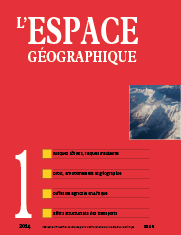

The tribal populations of Sanjay Gandhi National Park, Mumbai (India): A brief political ecology (3 fig., 3 tabl.)
Sanjay Gandhi National Park (SGNP) is still home to a population of Adivasi, or forest-dwelling tribal communities. Late in the 19th century, these minorities were alienated from their forest environment by colonial rulers, and the urban growth of Mumbai has since further restricted their livelihoods – this time no longer in the name of forestry but of biodiversity conservation. Here we recount the loss of territorial rights and resources by the Mumbai Adivasi and portray their present situation in the crossfire of land use lobbies. Surveys and interviews with a range of stakeholders reveal that current events represent just the latest chapter in a 200-year process of spatial and cultural marginalization of the Adivasi.
keywords: ENVIRONMENTAL CONFLICT, ETHNIC MINORITY, INDIA, LIVELIHOOD, MUMBAI, POLITICAL ECOLOGY URBAN NATIONAL PARK
Plonevez-les-Flots: An imaginary territory to highlight the dilemmas confronting local officials when managing coastal risks (3 fig.)
The mayors of coastal “communes” at risk of sea flooding and erosion face an increasingly complex situation. Coordinating their obligations, liabilities and responsibilities to safeguard people and property with their goals of economic and social development has been made even more difficult by the obligation to refer to a variety of texts and tools that proliferated after the dramatic storm, Xynthia, in 2010. This paper analyzes a complex situation from both a legal and geographic viewpoint and unveils gaps between the political level of coastal planning and a local level that must consider field constraints and stakeholders’ positions.
keywords: COASTAL RISK, EROSION, INTERDISCIPLINARITY, SEA FLOODING
Dynamics of an innovation system through the prism of spatial distribution: The case of cashew in Southwestern Burkina Faso (5 fig., 3 tabl.)
Innovation system is a key concept for analyzing sociotechnical change. Innovation system refers to a structure and functions that help develop and propagate innovation. This paper presents an original approach to the analysis of an innovation system using process of spatial distribution of an agricultural product: the cashew nut. The speed with which the cashew orchards spread and the way in which they do so are analyzed and contrasted with innovation system structure and function. The results show that measuring the spatial distribution process reveals the kind of networks involved, the strength of social interactions and identifies the system’s weaknesses.
keywords: BURKINA FASO, CASHEW NUT, FUNCTIONAL ANALYSIS, INNOVATION SYSTEM, SPATIAL DISTRIBUTION
Rootedness – Anchoring – Mooring: Reviving metaphors
Francophone academic literature makes abundant use of the notions of anchoring and rootedness when dealing with dwelling and residential practices. Though the metaphoric origin of these notions can be evoked, and even exploited by the authors, it is generally glossed over. This article seeks to revive the metaphorical dimension of these terms by adding two others – mooring and docking. Our goal is twofold. First, we demonstrate that by taking the terms seriously, it is possible to have them designate different types of of relationships to place, which directly use underlying images. Second, we discuss how these images participate in the poetics of knowledge that distills the effects of truth, whose motivations must be sought out in the major epistemological options that have been adopted.
keywords: ANCHORING, DWELLING, METAPHOR, POETICS, ROOTEDNESS
Global warning: Instrumentalizing islands
Islands fascinate people living on continents. Starting with this assessment, we will analyze the current debate on the consequences of global warming and demonstrate how small island states have been instrumentalized by a diverse coalition of experts, activists, journalists, celebrities, and politicians. The scenario of rising sea levels threatening islands and creating ‘‘climate refugees’’ has become a source of funding for island states posing as victims of development fin order to obtain compensation. We conclude by focusing on the Maldives and Tuvalu islands and the skillful media staging of their situation.
keywords: CLIMATE REFUGEES, DISCONTINUITY, GLOBAL WARMING, ISLAND, POLITICAL ECOLOGY
Book reviews
In this issue of l’Espace géographique, you will find critical reviews of the following books
PELLETIER P. (2013). Géographie et anarchie: Élisée Reclus, Pierre Kropotkine, Léon Metchnikoff et d’autres. Paris: Éditions Tec & Doc, Lavoisier, 230 p. (François Walter, université de Genève) ISBN: 978-2-915514-31-5
DONADIEU P. (2012). Sciences du paysage, entre théories et pratiques. Paris: Éditions Tec & Doc, Lavoisier, 230 p. (Hélène Douence, université de Pau et des Pays de l’Adour) ISBN: 978-2-7430-1405-6
LACQUEMENT G., MARTIN BORN K., VON HIRSCHHAUSEN B. (2012). Réinventer les campagnes en Allemagne. Paysage, patrimoine et développement rural. Lyon: ENS Éditions, 280 p. (Violette Rey, École normale supérieure de Lyon) ISBN: 978-2-84788-365-7
KRESL P.K., IETRI D. (2012). European Cities and Global Competitiveness. Strategie for Improving Performance. Cheltenham, Northampton: Edward Elgard, 318 p. (Guy Baudelle, université de Rennes 2) ISBN: 978-0-85793-828-2
REIGNER H., BRENAC T., HERNANDEZ F. (2013). Nouvelles idéologies urbaines. Dictionnaire critique de la ville mobile, verte et sûre. Rennes: Presses universitaires de Rennes, coll. «Espace et territoires», 178 p. (Guy Baudelle, université de Rennes 2) ISBN: 978-2-7535-2721-8
L’espace géographique 4/13![]()
![]() L’espace géographique 2/14
L’espace géographique 2/14
For subscribe or buy this issue: BELIN
![]() L’Espace géographique: contents
L’Espace géographique: contents
Last modified: August 7, 2014